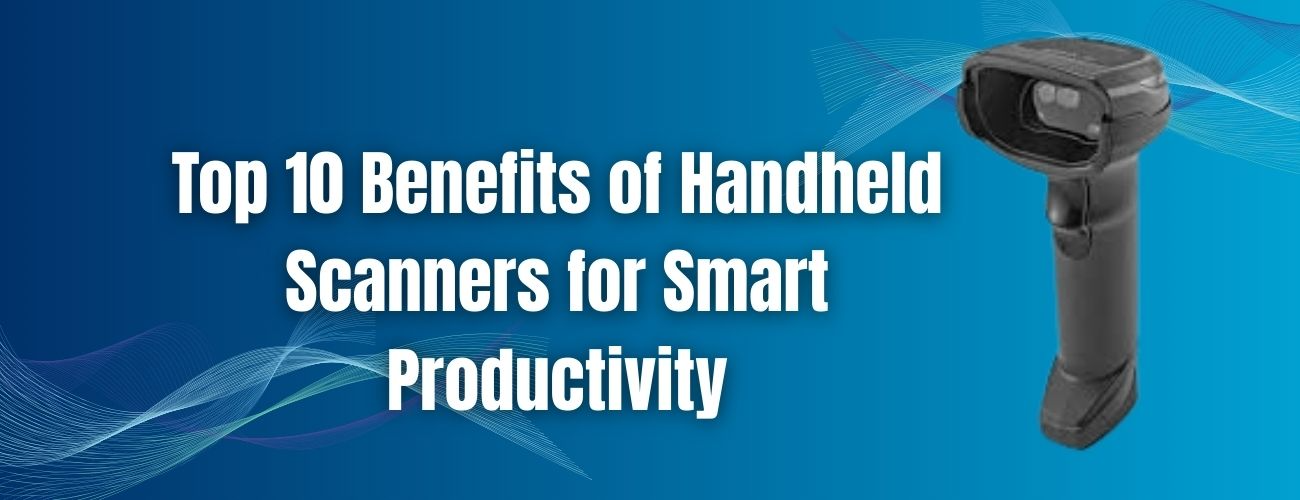The Ultimate Guide to Choosing the Best Handheld Scanner
In today’s modern day, it has become necessary to quickly record and store information and share it. This is where handheld scanners have become a necessity in homes, industries, and offices.
Unlike traditional flatbed scanners, which are generally large and bulky, this small and portable device can be used to scan and digitize documents, images, receipts, and even barcodes. A student ready to save lecture notes, a businessperson on top of receipts, or a librarian archiving ancient documents-all need a handheld scanner as the symbol of versatile efficiency.
What Is a Handheld Scanner?
The manual scanning device, intended for short and convenient usage, is used to obtain text, images, or codes from a surface by moving the device over it. Unlike fixed scanners, which require the document to be placed over a glass plate, these scanners require no such device and can be effortlessly used.
Due to their small size, such devices are suitable for travelling teachers, researchers, and mobile workers, and even for less formal users, who wish to digitize and make the transport of documents easy in the absence of heavy devices.
Benefits of Using a Handheld Scanner
1. Portability
The obvious benefit to having a portable scanner enough to fit into one’s hand is its facility for movement. It indeed has a small space to accommodate such devices in bags, fortunately, as well as pants pockets, and hence makes the best bet for students or professionals on the road looking to haul more than readable files abroad from the offices or homes.
2. Versatility
That is, the portable scanner can be used functionally for scanning receipts, barcodes, and even entire books. Some versions even contain OCR (optical character recognition) features, in that the scanned document can be converted and edited into a digital file.
3. Budget Friendly
Handheld scanners are less expensive than their more mainstream counterpart,s flatbed scanners. Thus, going handheld, referring particularly to those users who occasionally scan documents and are not willing to purchase big machinery for office use, is a more economically judicious option.
4. Space Saving
For people lacking adequate space, the handheld scanner is indeed a boon. No large desk, no specially allocated corner just for that purpose, this-to keep could be tucked away in a drawer or on a shelf until it is needed.
5. Time Efficiency
You do not need to worry about feeding documents if you use a handheld scanner. It only takes a quick swipe with the device over the paper to transform it into a digital file, which is almost instantaneous.
Common Uses of a Handheld Scanner
Students collect notes and pages from textbooks and diagrams.
- Business Professionals Track: Receipts, contracts, and expense reports.
- Medical Workers: Scanned patient forms and ID cards.
- Researchers: Document historical documents or rare books.
- Retailers: With barcode-enabled handheld scanners.
- Artists and Designers: Capture a sketch or be inspired by the physical world.
Types of Handheld Scanners
1. Capture Scanning Devices that Support Paper Documents
To digitize items such as receipts, contract agreements, and notes, a handheld scanner is meant for use with documents. Usually, professionals and students combine usage with the multipurpose formats and resolutions.
2. Handheld Barcode Scanners
Specialized in reading barcodes and QR codes, this is a stage that’s popular in retail and handling. One can install the newest version directly to the POS to ensure that speed and efficiency are improved.
3. Handheld Imaging and Photo Scanners
Scanners designed to capture detailed images or photographs at high resolution and color scanning usually support these kinds of capturing processes, as they keep detail and accuracy in the picture or slightly above.
4. Pen Style Handheld Scanners
This will be akin to a highlighter as it scans the line across it, converts instantly to the digital format. This is perfect for a language student, with an investigator and researcher in some cases.
Key Features to Consider When Buying a Handheld Scanner
Resolution
The best high-resolution handheld scanner would give the best kind of crisp, clear digital copies. If you’re thinking of scanning photographs or detailed documents, choose one with at least 600 dpi.
Connectivity
It should enable files for USB, Wi-Fi, or Bluetooth connectivity. For instance, scanning without wires into your scanner shouldn’t be a problem-the scanned file goes directly into your smartphone, tablet, or even your preferred cloud storage.
OCR Technology
If you need editable text, make sure your handheld scanner supports OCR. This is the feature that can convert all scanned text to the Word or PDF formats for editing.
File Formats
It should include the ability to save files in many different formats: JPEG, PDF, or PNG, for example.
Battery Life
For mobility purposes, a very long-life battery should be rechargeable. Some run rechargeable batteries, while others run disposable batteries for convenience while traveling.
Storage
Built-in memory is also available, with some devices that have the capability of using an external SD card. You won’t have to run out of space while scanning many materials.
How to Use a Handheld Scanner Effectively
- Lay the document flat on a surface.
- Position the handheld scanner at the very top of the page.
- Gently glide it down the page at a constant speed.
- Save the document in your own format.
- Transfer the data to your computer, handphone, or cloud storage for safekeeping.
Benefits of using a handheld scanner over normal scanners.
- Mobility: A handheld scanner is not tied to a place – unlike the desktop scanner.
- Easy Operation: Fast and easy to use.
- Cost-Effective: Cost is quite low compared to standard scanners.
- Multi-Use: Applicable for documents, books, and barcodes, too.
Potential Limitations of a Handheld Scanner
- Good things always come with their potential downsides:
- Sometimes manual scanning can yield an uneven or fuzzy image.
- Not always optimal for bulk scanning hundreds of pages.
- Some of the lower-priced models don’t feature high resolution or OCR.
Manuals for Usage and Maintenance of Your Handheld Scanner
- Keep the scanning lens clean for sharp images.
- Put it in its protective case while traveling.
- Don’t subject it to wetness or extreme temperatures.
- Have the companion software re-updated from time to time.
Future Trends in Handheld Scanners
With the advancement in technology, the handheld scanner is gradually changing day by day. Future models are likely to feature such specifications as:
- AI text recognition that is smart and accurate.
- Native cloud function that would deliver instant file storage.
- Professional image capture at higher resolutions.
- Extremely lightweight designs with long-lasting batteries.
Conclusion
Handheld scanners are more than toys; they’re productivity machines. From students who are digitizing notes to professionals who manage their receipt collection, handheld scanners make it possible for even the busiest of people to simplify converting their physical document assets into digital assets.
As the technology is advanced, the handheld scanner is also growing very smart, quick, and efficient. Investing in one today comes with the prospect of saving time, space, and effort tomorrow.
FAQ’s
1. Can You Scan Books With A Portable Scanner?
Given that the machine moves the pages rather than cracking the book open, flattening the book is not done, greatly reducing the chances of damage.
2. Do I Need The Technical Know-how To Use A Handheld Scanner?
Most models are pretty simple and require a steady hand to press a button or key.
3. Can I Use My Handheld Scanner With My Smartphone?
There are several that can be connected by Bluetooth or Wi-Fi, allowing direct transfer from scanning directly to the mobile device.
4. Aren’t Those Portable Scanners Useful For Businesses?
They’re terrific for copying contracts and invoices and for taking along a scanned copy of receipts when you travel.






